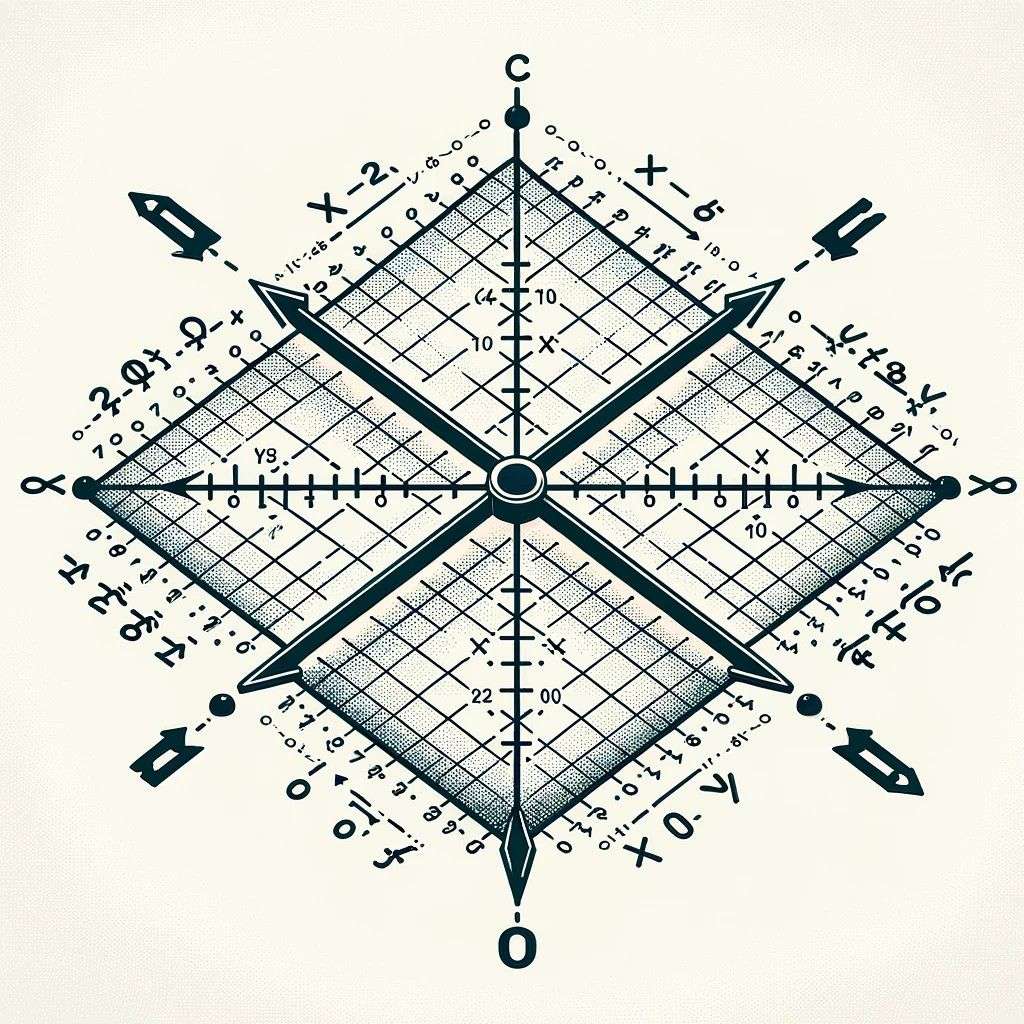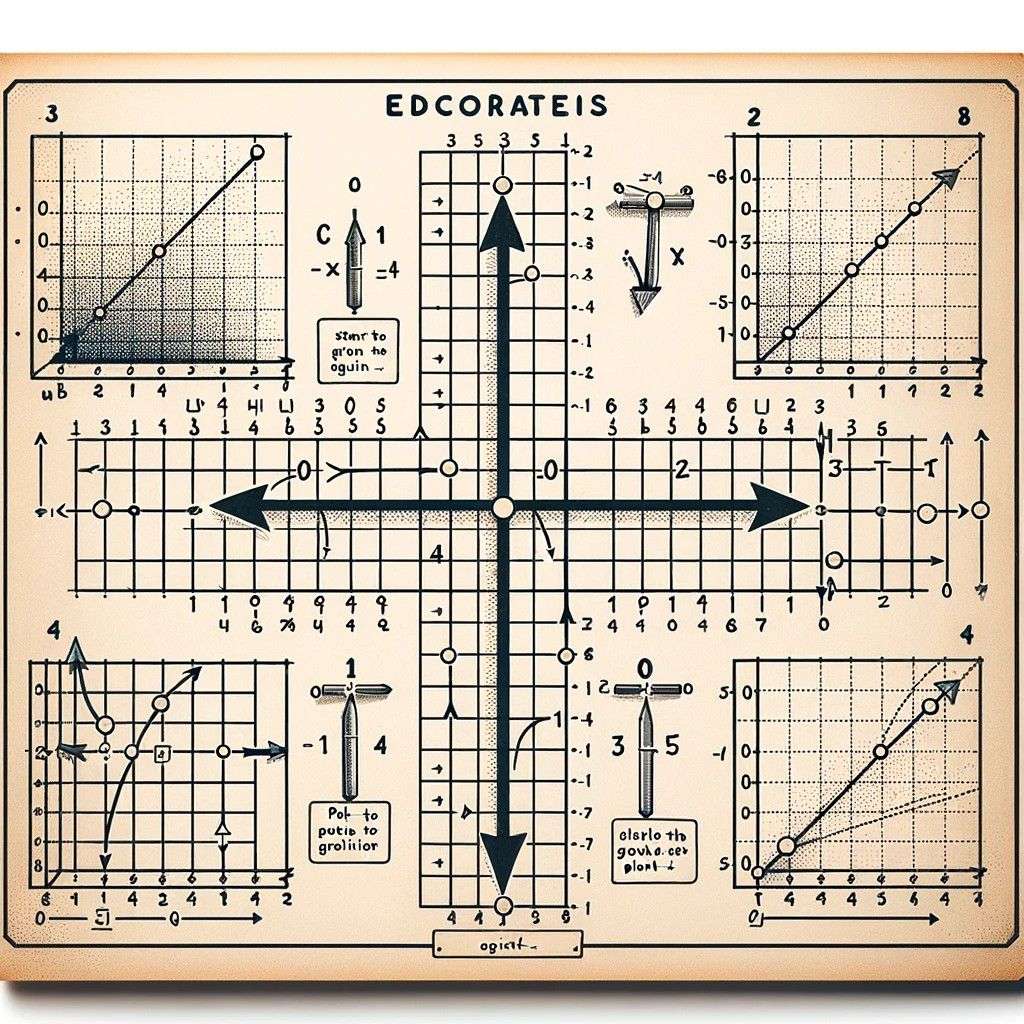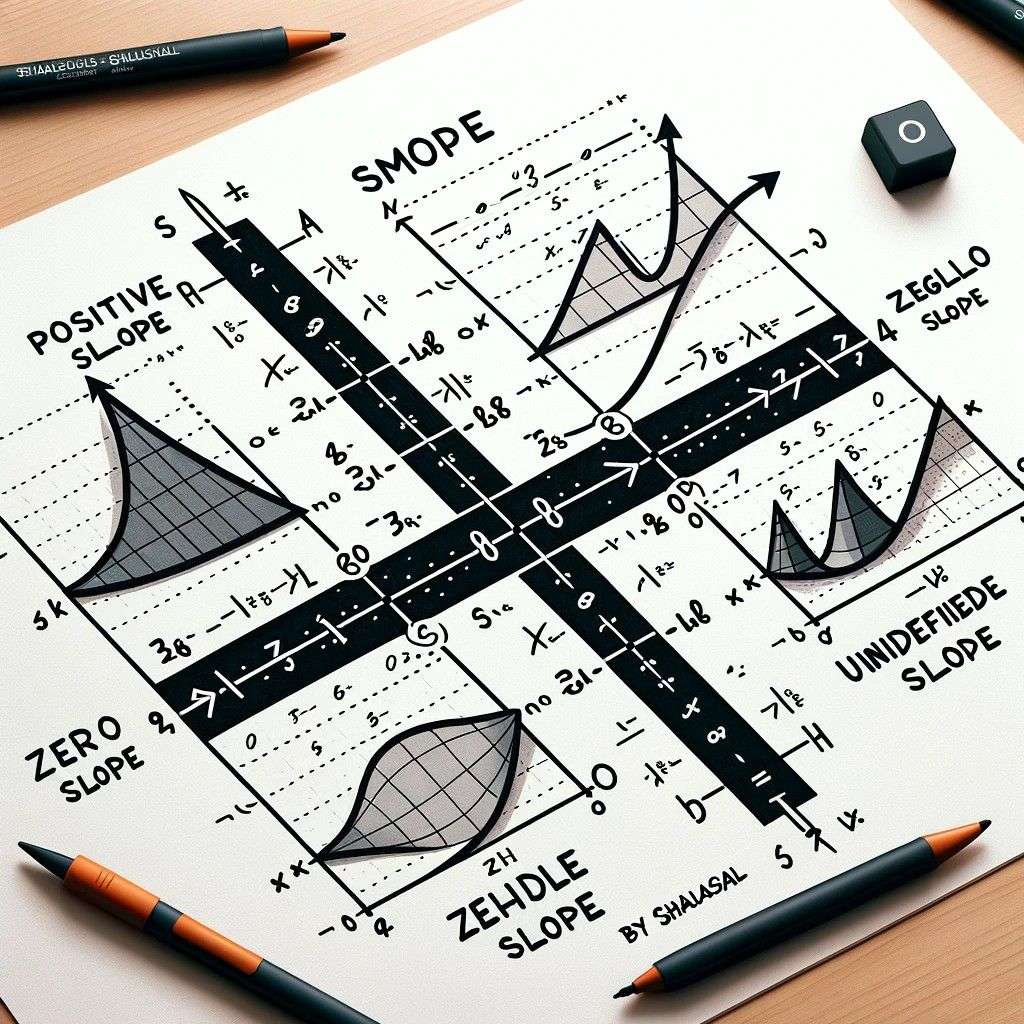
Understanding Coordinate Geometry: Essential Concepts and Applications

1. Introduction to Coordinate Geometry
Definition:
- Coordinate geometry, also known as analytic geometry, is a branch of mathematics that uses a coordinate system to uniquely determine the position of a point or geometric shape in a plane.
- It combines algebra and geometry, enabling the solution of geometric problems through algebraic equations.
Historical Background:
- The concept of coordinate geometry was primarily developed by the French mathematician René Descartes in the 17th century.
- Descartes’ work in this field was a groundbreaking union of algebraic and geometric principles, leading to the creation of the Cartesian coordinate system, named in his honor.
- This system introduced a way to describe geometric shapes through mathematical equations and vice versa, revolutionizing the way mathematicians and scientists approached geometry.
Importance in Mathematics:
- Coordinate geometry forms the foundation for many branches of mathematics, including calculus, which relies heavily on it for graphing functions and analyzing their properties.
- It provides a powerful tool for visualizing and solving complex problems in algebra and geometry by translating them into a set of equations or coordinates.
- Concepts from coordinate geometry are crucial in understanding and proving geometric theorems and properties.
Real-World Applications:
- In engineering and physics, coordinate geometry is used to model and solve real-world problems, like determining the trajectories of objects, designing structures, and analyzing forces.
- In computer graphics, it’s essential for rendering shapes, animations, and simulations.
- It plays a significant role in geography and cartography, where it helps in accurately mapping locations on Earth.
- Coordinate geometry is also fundamental in modern technologies like GPS and robotics, where positioning and movement are key components.
2. The Cartesian Coordinate System
Explanation of the Cartesian Plane:
- The Cartesian plane, named after René Descartes, is a two-dimensional plane for graphing points, lines, and curves.
- It is formed by two perpendicular number lines: the x-axis (horizontal) and the y-axis (vertical), intersecting at a point called the origin (0,0).
- Every point in the plane is represented by a pair of numbers, known as coordinates, which indicate its position relative to the two axes.
Understanding Axes: X-axis and Y-axis:
- X-axis: The horizontal axis of the Cartesian plane. It represents values from left (negative) to right (positive). In the context of a real-world scenario, it could represent time, distance, or any other variable.
- Y-axis: The vertical axis, perpendicular to the x-axis. It represents values from bottom (negative) to top (positive). It often stands for another variable or measurement different from the x-axis, such as height, cost, or temperature.
- Coordinates: A point on the plane is defined by two numbers (x, y). The ‘x’ value represents its horizontal position (left or right of the origin), and the ‘y’ value represents its vertical position (above or below the origin).
Quadrants and Their Significance:
- The intersection of the x and y-axes divides the plane into four quadrants, each with specific characteristics based on the sign of the coordinates.
- Quadrant I: Both x and y are positive. Points in this quadrant represent positive values for both variables.
- Quadrant II: Here, x is negative, and y is positive. This quadrant shows scenarios where one variable decreases while the other increases.
- Quadrant III: Both x and y are negative. Points in this quadrant are in the negative range for both variables.
- Quadrant IV: In this quadrant, x is positive, and y is negative. It represents situations where an increase in one variable corresponds to a decrease in the other.
- The significance of these quadrants lies in their ability to represent different relationships between two variables and their impact on understanding and solving mathematical problems.

The Cartesian Coordinate System is fundamental in mathematics as it provides a simple yet powerful way to visualize and analyze relationships between different variables.
3. Plotting Points in the Coordinate Plane
Definition and Representation of Points (x, y):
- In coordinate geometry, a point is defined by a pair of numerical coordinates: (x, y).
- These coordinates specify the point’s location on the Cartesian plane.
- The ‘x’ coordinate (abscissa) indicates the position along the x-axis (horizontal), and the ‘y’ coordinate (ordinate) shows the position along the y-axis (vertical).
Step-by-Step Guide to Plotting Points:
- Identify the Coordinates: Begin with the point you want to plot, represented as (x, y).
- Start at the Origin: Locate the origin (0,0) where the x-axis and y-axis intersect.
- Move Horizontally: Move along the x-axis from the origin. If ‘x’ is positive, move to the right; if negative, move to the left.
- Move Vertically: From your new position on the x-axis, move vertically along the y-axis. If ‘y’ is positive, move up; if negative, move down.
- Plot the Point: The intersection of these two movements is the location of your point. Mark it on the plane.
- Label the Point: Write the coordinates (x, y) near the plotted point for clarity.
Examples of Plotting Various Points:
- Example 1: Plot (3, 2)
- Start at the origin.
- Move 3 units to the right along the x-axis.
- From there, move 2 units up along the y-axis.
- Plot and label the point (3, 2).
- Example 2: Plot (-1, -4)
- Start at the origin.
- Move 1 unit to the left along the x-axis (since x is -1).
- Then move 4 units down along the y-axis (since y is -4).
- Plot and label the point (-1, -4).
- Example 3: Plot (0, 5)
- Start at the origin.
- Stay at the origin since x is 0.
- Move 5 units up along the y-axis.
- Plot and label the point (0, 5).

By following these steps, you can plot any point on the Cartesian plane accurately, which is a fundamental skill in coordinate geometry.
Distance Formula
Derivation of the Distance Formula:
- The distance formula in coordinate geometry calculates the distance between two points in the Cartesian plane. It is derived from the Pythagorean theorem.
- Consider two points: ( P_1(x_1, y_1) ) and ( P_2(x_2, y_2) ).
- To find the distance between them, construct a right triangle using these points as vertices.
- The horizontal leg of the triangle is the difference in x-coordinates, ( x_2 – x_1 ), and the vertical leg is the difference in y-coordinates, ( y_2 – y_1 ).
- The distance between ( P_1 ) and ( P_2 ) is the hypotenuse of this triangle.
- According to the Pythagorean theorem, the square of the hypotenuse (distance) is the sum of the squares of the other two sides.
- The distance formula is thus ( \sqrt{(x_2 – x_1)^2 + (y_2 – y_1)^2} ).
Application and Examples:
- Example 1:
- Calculate the distance between the points ( A(2, 3) ) and ( B(5, 7) ).
- Distance ( = \sqrt{(5 – 2)^2 + (7 – 3)^2} = \sqrt{3^2 + 4^2} = \sqrt{9 + 16} = \sqrt{25} = 5 ) units.
- Example 2:
- Find the distance between ( C(-1, 4) ) and ( D(-4, -2) ).
- Distance ( = \sqrt{(-4 – (-1))^2 + (-2 – 4)^2} = \sqrt{(-3)^2 + (-6)^2} = \sqrt{9 + 36} = \sqrt{45} ) units.
Solving Problems using the Distance Formula:
- The distance formula is widely used in various geometric problems, such as finding the length of a side of a triangle, the diameter of a circle, or the distance between two points in space.
- It can also be applied in real-world scenarios, like determining the straight-line distance between two locations on a map.
This formula is a fundamental tool in coordinate geometry, enabling the measurement of distances in a plane using algebraic methods.
5. Section Formula
Understanding Internal and External Division:
- The Section Formula is used to find the coordinates of a point that divides a line segment in a given ratio.
- Internal Division: When the point divides the line segment between two points, it is said to divide it internally.
- External Division: When the point divides the line segment produced beyond one of the points, it is known as external division.
Derivation and Application of the Section Formula:
- Consider a line segment between two points ( A(x_1, y_1) ) and ( B(x_2, y_2) ). Let ( P(x, y) ) be a point that divides AB in the ratio ( m:n ).
- For Internal Division:
- The coordinates of ( P ) are given by:
[ x = \frac{mx_2 + nx_1}{m + n} ]
[ y = \frac{my_2 + ny_1}{m + n} ] - For External Division:
- The formula is slightly modified for external division:
[ x = \frac{mx_2 – nx_1}{m – n} ]
[ y = \frac{my_2 – ny_1}{m – n} ] - These formulas are derived using the concept of weighted averages and proportions in geometry.
Practical Examples and Problem Solving:
- Example 1 (Internal Division):
- Find the point which divides the line segment joining ( A(2, 3) ) and ( B(8, 5) ) in the ratio 2:3 internally.
- Using the internal division formula, the coordinates of the point ( P ) are:
[ x = \frac{2 \times 8 + 3 \times 2}{2 + 3} = \frac{16 + 6}{5} = \frac{22}{5} ]
[ y = \frac{2 \times 5 + 3 \times 3}{2 + 3} = \frac{10 + 9}{5} = \frac{19}{5} ] - So, ( P \left(\frac{22}{5}, \frac{19}{5}\right) ).
- Example 2 (External Division):
- Find the coordinates of the point dividing the line segment joining ( C(4, -1) ) and ( D(-2, 3) ) in the ratio 3:2 externally.
- Applying the external division formula, the coordinates of the point ( P ) are:
[ x = \frac{3 \times (-2) – 2 \times 4}{3 – 2} = \frac{-6 – 8}{1} = -14 ]
[ y = \frac{3 \times 3 – 2 \times (-1)}{3 – 2} = \frac{9 + 2}{1} = 11 ] - Thus, ( P(-14, 11) ).
The Section Formula is a crucial tool in coordinate geometry for solving problems related to finding points on a line segment under various conditions of division.
Mid-Point Formula
Concept and Derivation of the Mid-Point Formula:
- The Mid-Point Formula in coordinate geometry is used to find the exact center point of a line segment by averaging the x and y coordinates of its endpoints.
- Given a line segment with endpoints ( A(x_1, y_1) ) and ( B(x_2, y_2) ), the midpoint ( M ) has coordinates that are the average of the coordinates of ( A ) and ( B ).
- The formula is derived as follows:
- The x-coordinate of ( M ) is the average of ( x_1 ) and ( x_2 ), given by ( \frac{x_1 + x_2}{2} ).
- Similarly, the y-coordinate of ( M ) is the average of ( y_1 ) and ( y_2 ), given by ( \frac{y_1 + y_2}{2} ).
- Hence, the Mid-Point Formula is ( M\left(\frac{x_1 + x_2}{2}, \frac{y_1 + y_2}{2}\right) ).
Applications in Geometry:
- The Mid-Point Formula is used to find the center of a line segment, which is essential in various geometrical constructions and proofs.
- It’s useful in problems involving symmetry, where the midpoint serves as a line of symmetry or a center of rotation.
- In coordinate geometry, it helps to find the center of rectangles, squares, and other figures where the diagonals intersect at their midpoints.
Worked Examples:
- Example 1:
- Find the midpoint of the line segment joining points ( P(4, 6) ) and ( Q(10, 12) ).
- Applying the formula, ( M = \left(\frac{4 + 10}{2}, \frac{6 + 12}{2}\right) = \left(\frac{14}{2}, \frac{18}{2}\right) = (7, 9) ).
- So, the midpoint is ( M(7, 9) ).
- Example 2:
- Calculate the midpoint of the segment connecting ( R(-2, 3) ) and ( S(8, -5) ).
- Using the Mid-Point Formula, ( M = \left(\frac{-2 + 8}{2}, \frac{3 + (-5)}{2}\right) = \left(\frac{6}{2}, \frac{-2}{2}\right) = (3, -1) ).
- The midpoint is ( M(3, -1) ).
The Mid-Point Formula is a fundamental concept in coordinate geometry, facilitating the analysis of geometrical figures and aiding in various practical applications.
Area of Triangles and Polygons
Using Coordinates to Determine the Area of Triangles:
- The area of a triangle with vertices (A(x_1, y_1), B(x_2, y_2),) and (C(x_3, y_3)) in the coordinate plane can be calculated using the formula:
[ \text{Area} = \frac{1}{2} \left| x_1(y_2 – y_3) + x_2(y_3 – y_1) + x_3(y_1 – y_2) \right| ] - This formula is derived from the concept of determinants in linear algebra, representing the area as half the absolute value of the determinant formed by the coordinates of the vertices.
Extension to Other Polygons:
- The concept can be extended to calculate the area of any polygon by dividing the polygon into triangles.
- For a polygon with more than three vertices, you can choose one vertex as a reference point and form triangles with this vertex and each adjacent pair of vertices in the polygon.
- Then, calculate the area of each triangle using the formula for the area of a triangle and sum up these areas.
Solving Numerical Problems:
- Example 1 (Triangle):
- Consider a triangle with vertices ( A(1, 2), B(4, 6), ) and ( C(5, 2) ).
- Apply the area formula:
[ \text{Area} = \frac{1}{2} \left| 1(6 – 2) + 4(2 – 2) + 5(2 – 6) \right| = \frac{1}{2} \left| 4 + 0 – 20 \right| = \frac{1}{2} \left| -16 \right| = 8 \text{ square units} ] - Example 2 (Polygon):
- For a quadrilateral with vertices ( P(1, 1), Q(4, 5), R(7, 2), ) and ( S(3, 3) ), divide it into two triangles, ( PQS ) and ( QRS ).
- Calculate the area of each triangle separately and sum them up to get the area of the quadrilateral.

These methods provide a systematic approach to calculating areas in coordinate geometry, useful for both theoretical problems and practical applications.
8. Slope of a Line
Definition and Significance of Slope:
- The slope of a line in coordinate geometry is a measure of its steepness or the angle of its incline.
- Mathematically, it is defined as the ratio of the vertical change (rise) to the horizontal change (run) between two points on the line.
- The slope is significant because it describes the direction and the steepness of the line. It is a key concept in calculus, physics, and various fields that involve rates of change.
Calculation of Slope between Two Points:
- Given two points ( A(x_1, y_1) ) and ( B(x_2, y_2) ) on a line, the slope ( m ) of the line is calculated as:
[ m = \frac{\text{change in y}}{\text{change in x}} = \frac{y_2 – y_1}{x_2 – x_1} ] - This formula represents the ratio of the difference in the y-coordinates to the difference in the x-coordinates of the two points.
Understanding Positive, Negative, Zero, and Undefined Slopes:
- Positive Slope: If ( y_2 > y_1 ) as ( x_2 > x_1 ), the slope is positive, indicating the line rises as it moves from left to right.
- Negative Slope: If ( y_2 < y_1 ) as ( x_2 > x_1 ), the slope is negative, meaning the line falls as it goes from left to right.
- Zero Slope: If ( y_2 = y_1 ), regardless of ( x ), the slope is zero. This indicates a horizontal line.
- Undefined Slope: If ( x_2 = x_1 ), the slope is undefined (or infinite), corresponding to a vertical line. This is because division by zero is not defined in mathematics.

Understanding the slope of a line is crucial for interpreting and solving problems in geometry, physics, economics, and other sciences where changes and trends need to be analyzed.
9. Equations of Lines
General Equation of a Line:
- The general form of the equation of a line in two dimensions is ( Ax + By + C = 0 ), where ( A ), ( B ), and ( C ) are real numbers, and ( A ) and ( B ) are not both zero.
- This form is versatile and can represent any straight line in the Cartesian plane.
Different Forms of Linear Equations:
- Slope-Intercept Form:
- Written as ( y = mx + b ) where ( m ) is the slope of the line and ( b ) is the y-intercept, the point where the line crosses the y-axis.
- This form is useful for quickly graphing a line and understanding its slope and vertical position.
- Point-Slope Form:
- Given as ( y – y_1 = m(x – x_1) ), where ( m ) is the slope and ( (x_1, y_1) ) is a known point on the line.
- This form is particularly useful when you have a point on the line and its slope, and need to find its equation.
- Two-Point Form:
- Derived from the point-slope form and is used when two points on the line, ( (x_1, y_1) ) and ( (x_2, y_2) ), are known. The equation can be manipulated from the point-slope form using the slope formula.
- Intercept Form:
- Expressed as ( \frac{x}{a} + \frac{y}{b} = 1 ), where ( a ) and ( b ) are the x-intercept and y-intercept of the line, respectively.
- Useful when the line’s intercepts are known.
Converting Between Different Forms:
- To convert between forms, use algebraic manipulations such as expanding, factoring, or using arithmetic operations.
- For example, to convert from the general form to the slope-intercept form, solve the equation ( Ax + By + C = 0 ) for ( y ).
- To find the point-slope form from two points, first calculate the slope ( m = \frac{y_2 – y_1}{x_2 – x_1} ), then substitute one point’s coordinates and the slope into the point-slope form.
Understanding these various forms of linear equations and how to convert between them is fundamental in coordinate geometry, aiding in solving diverse geometric problems and interpreting linear relationships.
10. Application of Coordinate Geometry in Solving Geometrical Problems
Real-World Problems and Solutions:
- Navigation and Mapping: Coordinate geometry is used in GPS technology to pinpoint locations and calculate distances and routes between points on the earth’s surface.
- Architecture and Engineering: Architects and engineers use coordinate geometry to design buildings and structures, ensuring accurate dimensions and spatial relationships.
- Computer Graphics: It’s essential in computer graphics for rendering images, animations, and simulations, where objects are positioned and manipulated in a virtual space.
- Robotics: In robotics, coordinate geometry helps in programming the movement and positioning of robots, particularly in manufacturing and automation.
Application in Other Fields of Study:
- Physics: In physics, it’s used to describe the motion of objects, such as plotting the trajectory of a projectile or the orbit of celestial bodies.
- Economics and Statistics: Coordinate geometry helps in graphing data, analyzing trends, and making predictions in these fields.
- Astronomy: Astronomers use it to map the positions of stars, planets, and other celestial bodies.
- Environmental Science: It aids in modeling environmental phenomena, like the spread of pollutants in an area or changes in geographical features.
Coordinate geometry is a versatile tool that extends far beyond pure mathematics, providing a framework for solving complex problems in numerous scientific and practical applications. Its ability to model and analyze spatial relationships and movements makes it indispensable in a wide range of disciplines.
11. Summary and Key Takeaways
Recap of Major Concepts:
- Coordinate System: Introduction to the Cartesian coordinate system, its axes, quadrants, and the method of plotting points.
- Distance and Section Formulas: Tools for calculating the distance between points and finding a point dividing a line segment in a certain ratio.
- Mid-Point Formula: A method to find the center point of a line segment.
- Area of Triangles and Polygons: Techniques to calculate areas using coordinates, applicable to various geometric shapes.
- Slope of a Line: Understanding the concept of slope, its calculation, and the different types of slopes.
- Equations of Lines: Different forms of linear equations (like slope-intercept, point-slope) and how to convert between them.
- Applications: Broad use of coordinate geometry in solving real-world problems and its relevance in various fields.
Importance of Coordinate Geometry in Higher Mathematics:
- Foundational for Calculus and Analytical Geometry: Coordinate geometry is crucial for understanding concepts in calculus, such as limits, derivatives, and integrals, especially in the context of graphing functions and analyzing their properties.
- Essential for Advanced Problem Solving: It provides powerful tools for solving complex problems in higher mathematics, including optimization problems, curve fitting, and geometric constructions.
- Interdisciplinary Applications: Its principles are applied in physics, engineering, computer science, and many other fields, making it a vital area of study for students pursuing careers in science and technology.
- Enhances Spatial Reasoning: Understanding coordinate geometry enhances spatial reasoning skills, which are critical in many scientific and engineering tasks.
In conclusion, coordinate geometry is not just a branch of mathematics but a fundamental tool that enriches our understanding of the world and enables us to solve complex problems across various disciplines. Its concepts form the backbone of many areas in higher mathematics and have practical applications in numerous scientific and technological fields.